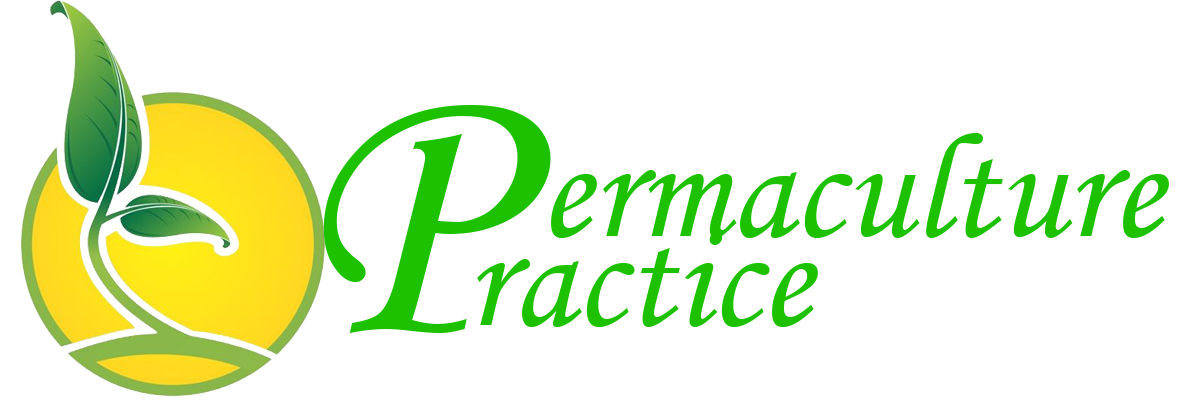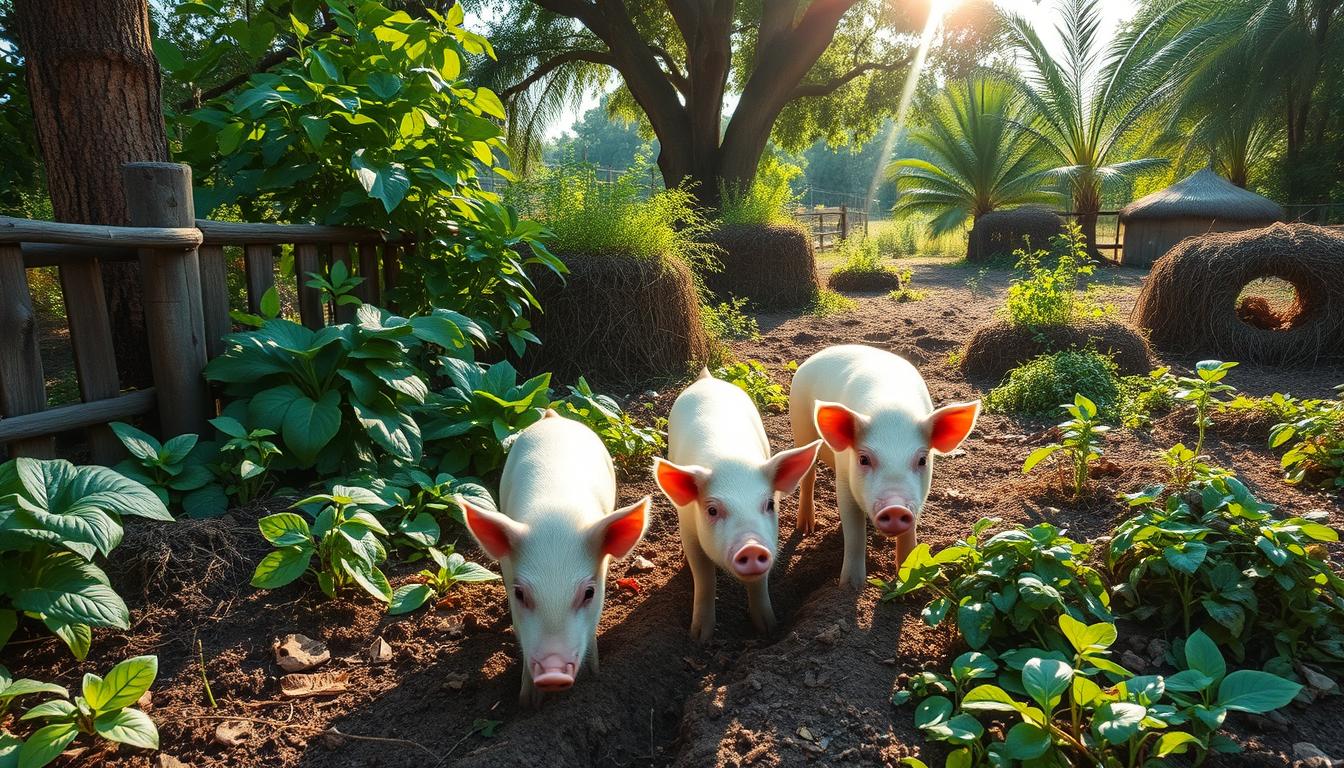Did you know that pigs can be an integral part of a thriving permaculture system? These intelligent, highly social animals can perform valuable tasks such as land clearing, soil preparation, and nutrient cycling. The use of pigs in a movable pen or “pig tractor” is a unique and effective way to prepare the land for planting in a permaculture garden.
Pigs have a natural tendency to dig, turn over sod, and uproot weeds and small trees. As they forage and root through the soil, they aerate the ground, break up hard-packed or clay-heavy areas, and create a weed-free, nutrient-rich seedbed for your permaculture garden. While pigs may be slower at plowing compared to machines or horses, they do a more thorough job, ensuring the land is ready for planting.
By strategically moving the pig tractor to different areas of your property, you can effectively manage soil compaction and ensure even coverage of the land. However, it’s important to note that pigs in a tractor setting can create mud and leave behind a significant amount of waste, which may pose nutrient runoff challenges in certain conditions. Proper site selection and waste management are crucial when integrating pigs into your permaculture system.
Introduction to Pigs in Permaculture
Pigs are intelligent and social animals that can be invaluable assets in permaculture systems. As Winston Churchill once said, “I like pigs. Dogs look up to us. Cats look down on us. Pigs treat us as equals.” These curious and adaptable creatures can form strong social bonds, making them well-suited for integration into permaculture farms and gardens.
Pigs as Intelligent and Social Animals
Pigs are known for their remarkable intelligence and social behaviors. They are highly inquisitive, capable of problem-solving, and demonstrate the ability to learn and remember. Pigs also form close-knit social groups, communicating through a range of vocalizations and displaying affectionate behaviors like nuzzling and playing.
Benefits of Using Pigs in Permaculture Systems
The integration of pigs into permaculture systems can provide numerous benefits. Pigs are effective biological plows, using their natural rooting and foraging behaviors to turn over and aerate the soil. This can help prepare the land for planting, eliminate weeds, and improve soil health. Pigs also produce nutrient-rich manure that can be composted and used as a valuable fertilizer, closing the loop and creating a more sustainable system.
By leveraging the unique characteristics and behaviors of pigs, permaculture practitioners can harness their power to enhance the productivity and resilience of their land. The intelligent and social nature of pigs makes them well-suited for integration, allowing for a harmonious and mutually beneficial relationship between these animals and the permaculture ecosystem.
Pig Tractoring: A Permaculture Approach
Pig tractoring, a versatile permaculture technique, harnesses the natural behaviors of pigs to prepare and maintain the land. Pigs possess a strong instinct to root and dig, which can be harnessed to clear and till the soil for various agricultural purposes. However, understanding the unique tendencies of pigs and their interactions with the environment is crucial for the success of a pig tractor system.
Understanding Pig Behavior and Tendencies
Pigs are intelligent and curious animals, and they will often try to escape their enclosures, dig under fences, and create muddy conditions if not managed properly. Permaculture practitioners must be mindful of these behavioral traits when designing and maintaining Pig Tractors to ensure the pigs’ well-being and the effectiveness of the system.
Building and Maintaining Pig Tractors
Pig tractors are sturdy, movable enclosures that allow pigs to be confined to a specific area of the garden or farm. These structures typically consist of a shed for shelter and an open yard area for the pigs to root and forage. The tractor is built using durable materials, such as 2×6 hemlock planks, to withstand the pigs’ digging and rooting behavior. Features like skids for easy movement and bracing to maintain the tractor’s structural integrity during relocation are essential. Proper Pig Tractor Maintenance, including providing adequate bedding and ensuring proper drainage, is crucial for the health and well-being of the pigs.
“Pigs can cover 400 square meters of the market garden area in four weeks, turning the soil upside down while removing starchy roots of grass.”
By understanding the Pigs as Biological Tractors and Harnessing Pig Behavior for Permaculture, permaculture practitioners can design and construct effective Pig Tractors that optimize the natural abilities of these intelligent animals to transform the land and enhance the overall productivity of their permaculture systems.
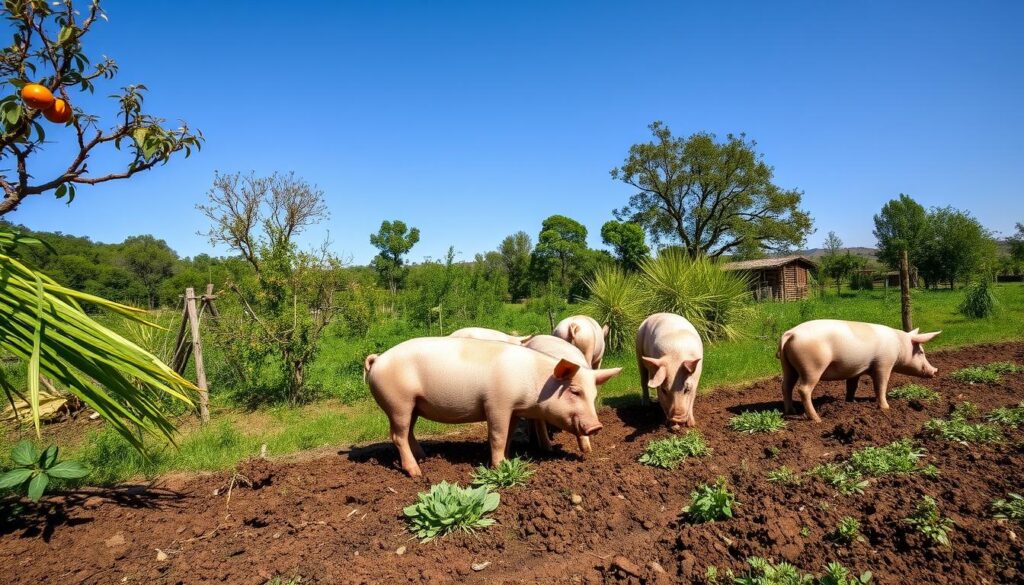
Integrating Pigs into Permaculture Gardens
Pigs can be an invaluable asset in permaculture gardens, helping to prepare the land for planting and maintain soil fertility. By confining pigs within a movable tractor, gardeners can direct them to specific areas that need tilling and weed control. As the pigs root and forage, they turn over the soil, uproot weeds, and incorporate organic matter, creating a fertile and well-aerated seedbed for crops.
Pigs for Land Preparation
The pig tractor can be moved progressively through the garden, allowing the pigs to systematically prepare the land for planting. This Pigs for Land Preparation approach is an excellent way to utilize the natural behaviors of pigs to improve soil quality and reduce the need for manual tilling.
Pigs in Permaculture Crop Rotation
Integrating pigs into a permaculture garden can be further optimized through the use of succession planting and crop rotation. After the pigs have prepared a section of land, it can be planted with a specific crop or cover crop, taking advantage of the freshly tilled and nutrient-rich soil. As the pigs move to a new area, the previously tracted land can be planted with the next crop in the rotation, creating a diverse and resilient Pigs and Permaculture Polycultures system.
https://www.youtube.com/watch?v=pB6t7JK-9MI
This approach helps maintain soil fertility, suppress weeds, and promote ecosystem balance, making pigs an invaluable Pigs as Permaculture Garden Helpers in the permaculture garden.
Pigs in Permaculture
Pigs are well-suited for integration into permaculture systems due to their ability to perform valuable tasks, their efficient utilization of on-farm resources, and their contribution to the overall sustainability of the ecosystem. By harnessing the natural behaviors of pigs as permaculture livestock, permaculture farmers can leverage these animals to prepare the land, control weeds, and generate nutrient-rich fertilizer, all while promoting biodiversity and closed-loop resource cycling.
Studies have shown that the diet of wild boar in the French Alps consists primarily of roots (39%), fleshy fruits (21%), and green parts of plants (17%), with the remaining portion comprising forest fruits, maize, humus, animal matter, and mushrooms. This diverse foraging behavior is well-suited for integrating pigs into permaculture systems, as pigs can efficiently utilize a wide range of on-farm resources.
Permaculture farmers often plant annual crops such as brassicas, beets, beans, peas, maize, and clover in rotation to provide a diverse forage source for their pigs. In fact, foraging and plant-based sources can provide up to 84% of a pig’s natural diet, reducing the need for purchased feed and aligning with the principles of pigs and permaculture.
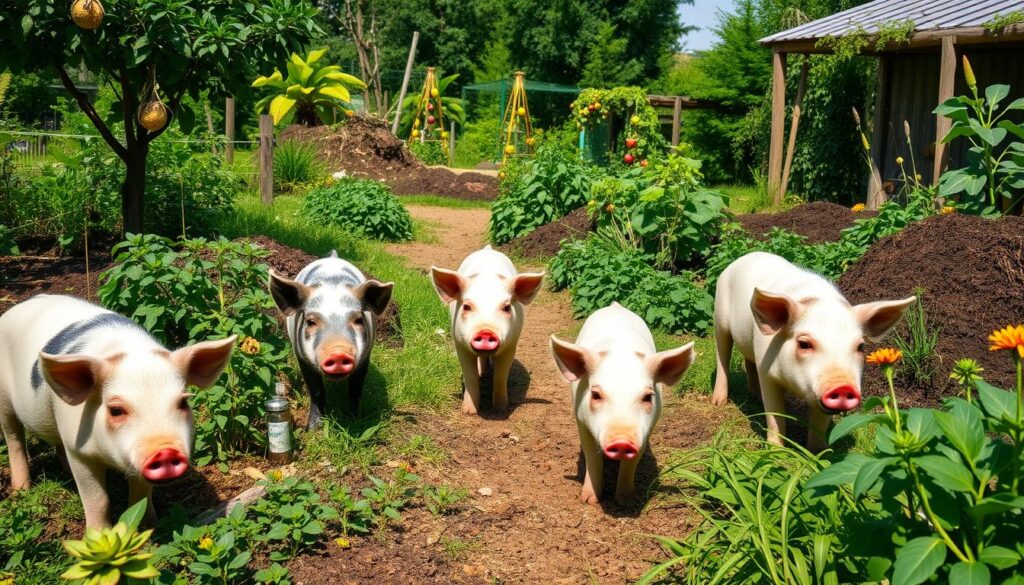
By utilizing pigs as part of a land-based permaculture system, farmers can optimize the use of over 1,000 square meters of space. Pigs are provided with a diverse range of hedge plants, including hawthorn, blackthorn, sea buckthorn, guelder rose, hazel, sweet chestnut, oak, wild apple, wild pear, and rowan, which serve as both forage and shelter.
Waste Management: Utilizing Pig Manure
In permaculture, pigs are not only intelligent and social animals but also prolific producers of nutrient-rich manure. This waste can be a valuable resource when properly managed, contributing to the overall sustainability of the system.
Composting Pig Manure
Pig farms generate large amounts of waste, including manure, urine, and leftover feed. The manure is rich in essential nutrients such as nitrogen, phosphorus, and organic matter. By composting this waste, permaculture farmers can create high-quality compost that can be used to enrich the soil and support plant growth. The process involves containing the pig waste, layering it with carbon-rich materials like straw or wood chips, and allowing it to break down through the action of microorganisms.
Using Pig Manure as Fertilizer
In addition to composting, pig manure can also be directly applied to the land as a nutrient-rich Pig Manure as Permaculture Fertilizer. Pigs are Pigs as Manure Producers, and their waste is high in essential nutrients for plant growth. By strategically applying the manure to gardens, orchards, and other cultivation areas, permaculture farmers can Applying Pig Waste to Crops and promote soil fertility, Utilizing Pig Waste in Permaculture. This Nutrient-Rich Pig Manure helps to reduce the need for external inputs and supports the Pig Manure Composting closed-loop, regenerative approach to agriculture.
“Proper waste management reduces the risk of disease transmission among animals and humans, while composting manure can reduce the need for chemical fertilizers and contribute to soil fertility.”
Feeding Pigs in Permaculture Systems
Feeding pigs in a permaculture system relies on the efficient utilization of on-farm resources. Pigs are omnivores and can thrive on a diverse diet of agricultural byproducts, fallen fruits, and other organic materials available within the permaculture system. This can include crop residues, food scraps, and even forage from the land itself, such as roots, tubers, and. By minimizing the need for purchased feed, permaculture farmers can reduce their reliance on external inputs and create a more self-sustaining pig-rearing system.
Utilizing On-Farm Resources
Permaculture systems aim to maximize the use of on-farm resources for Feeding Pigs in Permaculture. This can involve incorporating Pigs and Permaculture Feedstocks such as fallen fruits, vegetable scraps, and other organic materials into the pigs’ diet. By leveraging these On-Farm Pig Feed sources, farmers can reduce their reliance on purchased feeds and promote a more sustainable and self-sufficient Pigs in Permaculture operation.
Supplementing with Purchased Feed
While permaculture systems aim to maximize the use of on-farm resources, there may be instances where Supplemental Pig Feed in Permaculture is necessary to supplement the pigs’ diet and ensure their optimal health and growth. This may involve the addition of protein-rich feeds, minerals, or other essential nutrients that may not be readily available from the on-farm sources alone. Permaculture farmers must carefully Balance Pig Diets by Integrating Purchased Feeds with the integration of local, regenerative resources to maintain the overall sustainability and self-sufficiency of the pig-rearing system.
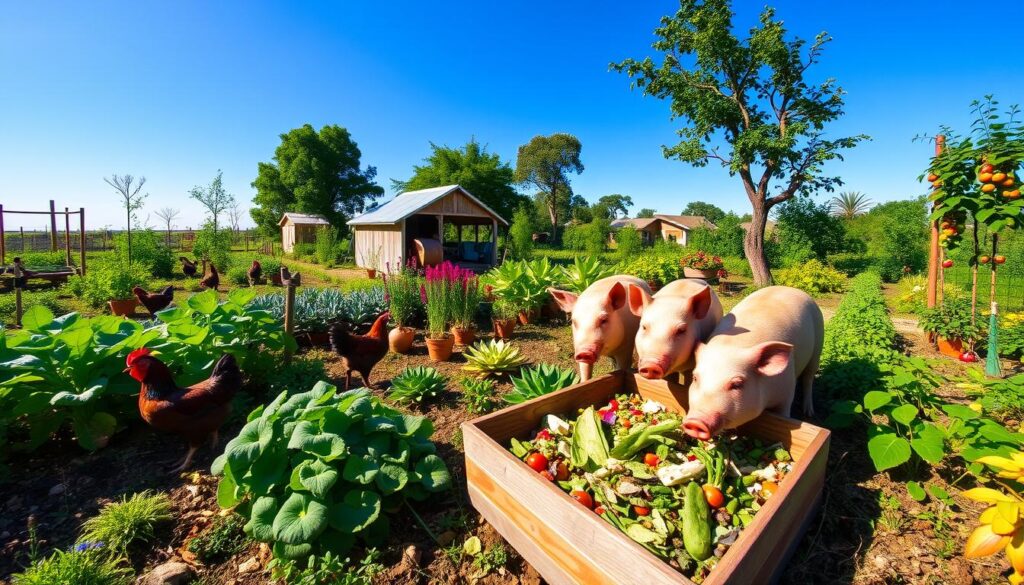
“Nearly 100 years ago, J. Russel Smith proposed feeding animals tree crops along with grain, where grain would constitute only a small part of their diet.”
Pig Breeds for Permaculture
When integrating pigs into a permaculture system, the choice of pig breed can significantly impact the success and efficiency of the system. Permaculture farmers often favor heritage or traditional pig breeds that are well-adapted to foraging, rooting, and thriving in a more natural, outdoor environment. Breeds such as Mangalitsa, Meishan, and Kune Kune are known for their hardiness, grazing abilities, and suitability for pasture-based systems.
These heritage pig breeds are typically better equipped to navigate the diverse landscapes and forage on the varied resources found in permaculture farms, making them a valuable addition to the ecosystem. Their natural behaviors and adaptations align well with the principles of Pig Breeds for Permaculture, allowing them to contribute to the overall productivity and resilience of the permaculture system.
“One pig can reportedly feed a family for at least two years.”
When selecting pigs for permaculture, it’s essential to consider the specific traits and characteristics of different breeds. Breeds like the Berkshire, Gloucester Old Spots, and Guinea Hogs are known for their excellent foraging abilities and suitability for outdoor, pasture-based systems. These heritage pig breeds can thrive in the diverse environments found in permaculture farms, making them a valuable addition to the overall system.
By carefully selecting pigs for permaculture, farmers can leverage the unique strengths and adaptations of various breeds to enhance the productivity, sustainability, and resilience of their permaculture systems. The integration of these heritage pig breeds can contribute to the overall balance and harmony of the permaculture ecosystem.
Pasture-Based Pig Rearing
Incorporating Pigs in Permaculture Pastures is a key aspect of sustainable farming. By providing Pasture-Raised Pigs with access to diverse grazing areas, permaculture farmers can leverage the animals’ natural foraging behaviors to maintain the health and productivity of the land. Rotational Grazing for Pigs is a strategic approach that allows pigs to graze on a variety of forage plants, while also allowing the land to rest and recover between grazing periods.
Designing Rotational Grazing Systems
Designing a rotational grazing system involves dividing the pasture into smaller sections and moving the pigs between these sections at regular intervals. This approach helps prevent overgrazing, promote soil regeneration, and ensure a balanced ecosystem. By carefully managing the pigs’ movement and access to different areas of the pasture, farmers can optimize the benefits of Pasture-Raised Pigs in their permaculture systems.
“Pigs happily eat grasses and roots while turning over soil, and are provided with organic grain, food scraps, clean water, mobile shelters, and mud wallows as payment.”
The integration of Pigs in Permaculture Pastures is a symbiotic relationship, where the pigs’ natural behaviors contribute to the overall health and productivity of the land. By carefully designing and managing their Rotational Grazing for Pigs, permaculture farmers can create a sustainable and resilient system that benefits both the animals and the environment.
Holistic Pig Management
Integrating pigs into a permaculture system requires a comprehensive approach to their management. Successful Holistic Pig Rearing involves understanding the physical, behavioral, and environmental needs of these intelligent and social animals, as well as their role within the broader Pigs in Permaculture Ecosystems.
Permaculture farmers must closely observe their pigs, monitor their health and welfare, and make adjustments to their housing, feeding, and grazing regimes to ensure the animals thrive and contribute positively to the overall Integrated Pig Management system. By adopting a holistic perspective, permaculture farmers can create a harmonious and sustainable integration of pigs within their regenerative agricultural practices.
“Pigs are remarkable animals that can play a vital role in a permaculture system, but their care requires a comprehensive approach that addresses their unique needs and abilities.”
From providing adequate space (recommended minimum of 20 square feet per pig) to ensuring proper feeding (1 lb of food per day for each month of age up to 6 lbs per day) and processing at the ideal weight (220 to 250 lbs), holistic pig management is essential for the well-being of the animals and the success of the permaculture system.
By carefully considering the pigs’ needs and integrating them seamlessly into the permaculture ecosystem, farmers can unlock the full potential of Pigs in Permaculture Ecosystems and create a thriving, sustainable agricultural system.
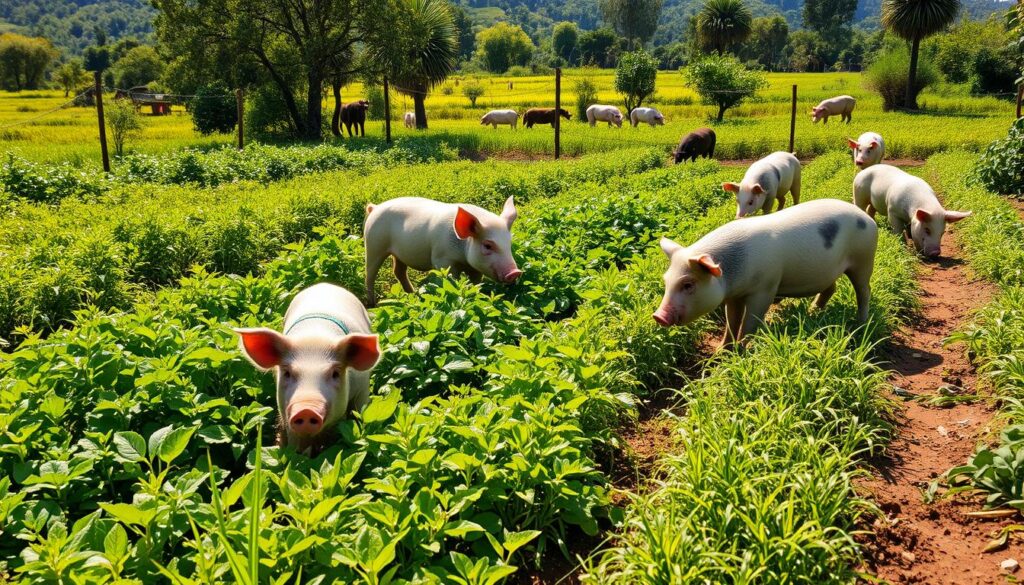
Integrating Pigs with Other Livestock
Pigs can be seamlessly integrated with other livestock species within a permaculture system, creating synergistic relationships and enhancing the overall resilience of the farm. By carefully designing these Pigs in Permaculture Polycultures, permaculture farmers can optimize resource use, promote biodiversity, and cultivate a more self-sustaining and productive agricultural ecosystem.
For instance, pigs can be utilized to prepare the land for poultry, whose Pigs and other Livestock scratching and foraging behaviors can further refine the soil and distribute the pig manure. Ruminants, such as cattle or sheep, can then graze on the pasture after the pigs have rooted and tilled the soil, utilizing the available forage and contributing their own manure to the system.
“Many diseases and insect pests overwinter in dropped fruits and nuts, emphasizing the importance of livestock such as hogs, chickens, or turkeys in breaking the life cycle of pests by consuming these dropped fruits and nuts.”
This Synergistic Relationships in Permaculture allows for efficient resource utilization and promotes a diverse, self-sustaining ecosystem. By integrating different livestock species, permaculture farmers can leverage the unique strengths and behaviors of each animal, creating a harmonious and productive system that mimics natural ecosystems.
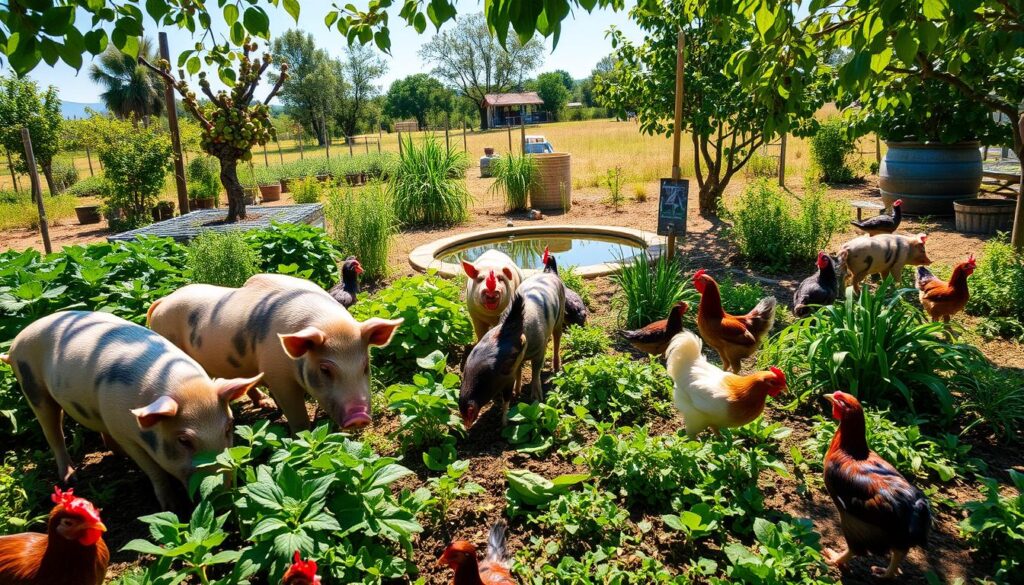
Pig Tractor Design Considerations
Integrating pigs into a permaculture system requires careful consideration of the design and construction of effective pig tractors. These mobile enclosures play a crucial role in maximizing the benefits of pig tractoring while ensuring the well-being of the animals. When designing effective pig tractors, several key factors must be taken into account.
Firstly, the size and mobility of the tractor are essential. It should be large enough to provide adequate space, shelter, and access to water for the pigs, while remaining light and maneuverable enough to be easily moved between different areas of the farm. The materials used in pig tractor construction must be durable and weather-resistant, ensuring the tractor can withstand the elements and maintain its structural integrity.
“Careful design of pig tractors is crucial for the successful integration of pigs into a permaculture system.”
Another important consideration is the incorporation of shelter and shade within the tractor. Pigs require protection from the sun and inclement weather, and the tractor design should accommodate these needs. Additionally, the ease of moving the tractor between different areas of the farm is a crucial factor, as it allows for effective succession planting and crop rotation strategies.
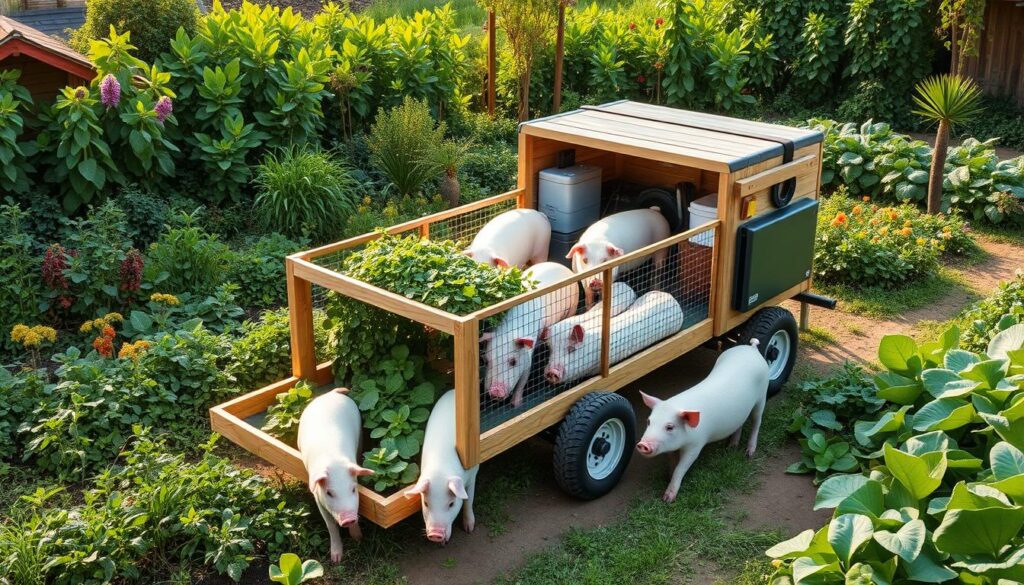
Ultimately, the factors in pig tractor design must ensure the pigs’ well-being while maximizing the benefits of their presence in the permaculture system. By carefully considering these design elements, farmers can create efficient and effective pig tractors that contribute to the overall success of their permaculture operations.
Ethical and Humane Treatment of Pigs
Maintaining the ethical and humane treatment of pigs is a fundamental aspect of integrating these animals into a permaculture system. Permaculture farmers must prioritize the pigs’ physical and psychological well-being, providing them with appropriate living conditions, ample space to roam and forage, and access to natural behaviors. This includes designing pig tractors and pastures that allow for natural behaviors, minimizing stress, and ensuring the pigs are free from pain, distress, and discomfort.
By upholding high standards of animal welfare, permaculture farmers can create a more sustainable and responsible pork production system that aligns with the principles of permaculture. This approach not only benefits the pigs but also contributes to the overall health and resilience of the entire permaculture ecosystem.
“Pigs have nearly 200 times the concentration of ethmoidal cells in their noses compared to humans, indicating their heightened sense of smell and the importance of providing them with a stimulating and enriching environment.”
Permaculture practices, such as rotational grazing and integrated pest management, can help create a thriving environment for pigs while minimizing the need for intervention and promoting their natural behaviors. By embracing the Humane Pig Rearing and Ethical Pig Farming principles, permaculture farmers can ensure the Animal Welfare in Permaculture is prioritized, leading to healthier, happier pigs and a more sustainable food production system.
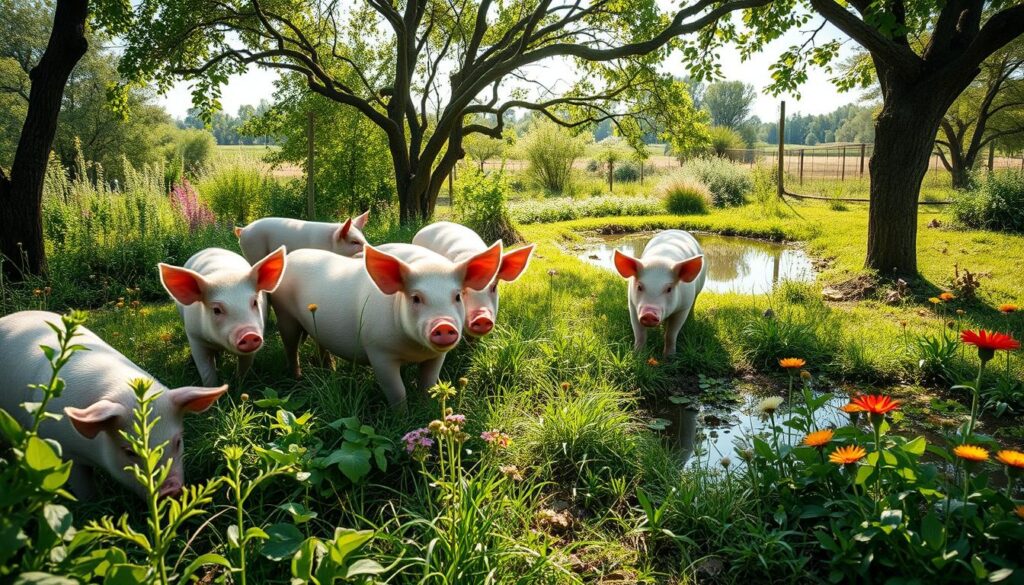
Conclusion
Integrating pigs into a permaculture system can be a highly effective and sustainable approach to agriculture. By leveraging the natural behaviors and capabilities of pigs, permaculture farmers can utilize these animals to prepare and maintain the land, manage waste, and contribute to the overall productivity and resilience of the ecosystem. Through techniques like pig tractoring, composting pig manure, and designing holistic management systems, permaculture farmers can create a harmonious and synergistic relationship between pigs and the broader permaculture landscape.
By embracing the role of pigs in regenerative agriculture, permaculture practitioners can unlock the full potential of these intelligent and versatile animals, contributing to the creation of a more sustainable and self-sufficient food production system. The relatively low cost and effort required to maintain guinea pigs in permaculture systems, combined with their efficient resource use and ability to enrich the soil, make them an ideal addition to a holistic and integrated permaculture approach.
As the permaculture movement continues to gain momentum, the integration of pigs into sustainable farming practices will undoubtedly play a crucial role in developing a more resilient and ecologically balanced food system. By harnessing the power of these remarkable animals, permaculture farmers can create a more harmonious and regenerative future for both people and the planet.
